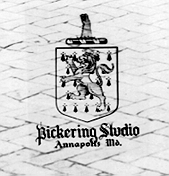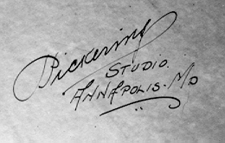![]()
Edgar H. Pickering was born in Rhode Island on June 19, 1892.[1] After his birth, the first information known about him is that he served in World War I.[2] The first time he is to be found in Maryland is in Baltimore in 1919, when the 27 year old Pickering married 22 year old Margaret E. Brookey on July 12 in St. Gregory's rectory.[3] In the 1920 census and Baltimore City Directory, he is listed as a photographer, but since he and his wife are living in a flat at the time and there is no work address listed for him, is is possible that he was working as a junior photographer in one of the studios in Baltimore.[4] In 1920 the Pickerings moved to Camp Meade (now Fort George G. Meade), possibly because Edgar was working as an army photographer, but once again they only stayed for a short while. In August of 1922, the couple moved to Annapolis, MD[5] and set up a studio on 29 Maryland Avenue in what is now the Historic District in that city.[6] The studio prospered during the twenties; E. H. Pickering, as he signed his photographs, became the yearbook photographer for St. John's College and a well respected architectural photographer[7]. None of his portrait work has survived outside what is in the St. John's yearbooks and private collections around Annapolis, but the Maryland State Archives owns many prints and 8"x10" negatives of historic homes and street scenes in and around Annapolis and the rest of Maryland.
In 1927, Pickering's wife divorced him,[8] and a year later 36 year old Edgar married 20 year old Margaret (or Marguerite) A. Fitch, a native Annapolitan, on July 13.[9] Their only child, daughter Betty Ann, was born in June of 1929.[10] However, at the height of his success, Pickering's career in Annapolis was ended by circumstances beyond his control. The Crash of 1929 meant that the disposable income photographers depend upon entirely disappeared, and like many photographers Pickering was forced to close his studio. In an effort to remain solvent in early 1931, he took out not only a real estate mortgage, but also a chattel mortgage (a mortgage on the contents of his studio). Unfortunately, by the end of 1931 Pickering could not meet the terms of his mortgage, and the bank forclosed on him. In the records of the foreclosure proceedings, there is a complete inventory of his studio; an invaluable record of the contents of a moderately successful studio in the early thirties[11]. His studio was bought by Howard Haymen, Sr, another local photographer in Annapolis, and later many of Pickering's prints and negatives were given to the Maryland State Archives by Howard Hayman's son.[12]
After the sale of his studio in early 1932, the Pickerings left Annapolis. I have been unable to locate them in the mid and late thirties, but Pickering's work does appear in the Historic American Buildings Survey (HABS) files[13]. HABS was started in 1934 as a way to document America's historic structures, and as a talented and known architectural photographer, it is probable that HABS either purchased Pickering's work or hired him as a photographer[14]. It is likely that the Pickerings moved to Washington directly after leaving Annapolis, but that is pure speculation. However, Edgar and Margaret Pickering are to be found in the 1940 Washington, D. C. phone book, and Edgar is listed as a photographer for the Department of Agriculture[15]. They are both living in a rented apartment on Queen Street, NE[16], and remain there through 1948[17]. Edgar is listed alternately as a photographer and a lab technician in the phone books, but on his World War II ration book he is listed as a photographer, so it is likely that he alternated between photographing in the field and developing photographs in the lab in Washington.[18] In 1947 he was forced to retire from professional photography because of ill health, but he remained in Washington, DC for the next twenty years.[19] In April of 1969 he moved to Scottsdale, Arizona with his wife Marguerite, probably to join his daughter Betty, and died three months later on June 22, 1969.[20] He left behind a wonderful photographic legacy for students of Early American architecture and material culture.

 The
images on this page are three of the ways that E. H. Pickering would sign
his photographs. He also numbered each of his negatives, and this number
would appear on the final print, usually in the lower corners, but sometimes
hidden in bushes or trees.
The
images on this page are three of the ways that E. H. Pickering would sign
his photographs. He also numbered each of his negatives, and this number
would appear on the final print, usually in the lower corners, but sometimes
hidden in bushes or trees.
© Copyright July 22, 1997 Maryland State Archives